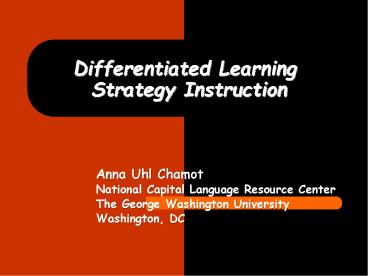Differentiated Learning Strategy Instruction - PowerPoint PPT Presentation
Title:
Differentiated Learning Strategy Instruction
Description:
Differentiated Learning Strategy Instruction Anna Uhl Chamot National Capital Language Resource Center The George Washington University Washington, DC – PowerPoint PPT presentation
Number of Views:533
Avg rating:3.0/5.0
Title: Differentiated Learning Strategy Instruction
1
Differentiated Learning Strategy Instruction
- Anna Uhl Chamot
- National Capital Language Resource Center
- The George Washington University
- Washington, DC
2
OBJECTIVES
- Suggest guidelines for teaching language learning
strategies. - Explain how to identify and expand students
learning strategies. - Suggest ways to differentiate instruction for
diverse learners.
3
DIVERSITY IN LANGUAGE PROFICIENCY AND LEARNING
STRATEGY KNOWLEDGE/ USE
- Low to high language proficiency levels.
- Low to high levels of learning strategy
knowledge/ use (how to learn skills). - Means at least four combinations of language
proficiency learning strategy knowledge/ use.
4
(No Transcript)
5
UNDERSTANDING STUDENTS VARIED APPROACHES TO
LEARNING
- Ask students how they complete specific tasks.
- Ask students' other teachers how your students
learn in their classes. - Have students identify favorite subjects,
interests, special abilities. - Identify students learning strategies for both
language and content tasks.
6
WHAT ARE LEARNING STRATEGIES?
- Students thoughts and actions that assist their
learning. - Ways to understand, remember, and recall
information. - Ways to practice skills more efficiently (Chamot,
2009).
7
IDENTIFY STUDENTS CURRENT LEARNING STRATEGIES
- Class discussions about strategies.
- Interviews with students.
- Learning strategy journals.
- Student think-alouds.
- Questionnaires and checklists.
8
EXPAND STUDENTS CURRENT LEARNING STRATEGIES
- Model how to use the learning strategy.
- Name the strategy in the target language.
- Tell when and how to use it.
- Students tell how they use it (if they already
do). - Make strategies concrete with visuals and realia!
- Have students practice and evaluate their use of
learning strategies.
9
DEVELOP STUDENTS METACOGNITION
- Model metacognitive awareness.
- Ask students to describe their thinking
processes. - Have students take increasing responsibility for
their own learning.
10
WHAT IS DIFFERENTIATED INSTRUCTION?
- Provides instruction for diverse learners
- Builds on learners prior knowledge
- Addresses students interests and needs
- Provides alternate paths to achievement
- Assesses important concepts and skills
- Uses varied rates of instruction and
- Organizes the classroom into collaborative
learning teams.
11
WHY DIFFERENTIATE INSTRUCTION?
- Provides access and success for all students.
- Increases student motivation.
- Leads to more efficient learning.
12
WHEN TO DIFFERENTIATE
- When students are unmotivated, bored, or
struggling. - As a reward for accomplishment.
- When teaching a combination level class.
- When disparity exists in students language
proficiency and their content knowledge. - When the teacher needs to work with one group.
13
(No Transcript)
14
PLANNING DIFFERENTIATED INSTRUCTION AND
ASSESSMENT - 1
- Identify important concept or big idea
enduring understanding all students should
achieve (Wiggins McTighe, 2006). - Identify language proficiency and learning
strategy knowledge/ use of each student and use
to group students. - List different ways you could teach the concept
(listening, reading, Internet search,
demonstration, video, role play, game, project,
oral and written reports, etc.).
15
PLANNING DIFFERENTIATED INSTRUCTION AND
ASSESSMENT - 2
- Develop language, content, and learning strategy
objectives and assessments for mid group (Anchor
Task). - Plan learning activities to achieve Anchor Task
objectives. - Identify scaffolding needed by LLP and LSKU
students to achieve the same objectives
(Scaffolded Task) plan assessment.
16
PLANNING DIFFERENTIATED INSTRUCTION AND
ASSESSMENT - 3
- Plan expansion and independent activities for HLP
and HSKU students to achieve the same objectives
(Independent Task) plan assessment. - Assign LLP HLSKU and HLP LSKU students to one
of the three groups, depending on the task.
17
EXAMPLES OF DIFFERENTIATED ACTIVITIES
- Complexity Ladder
- Individual Agendas
- Learning Contracts
- Group Folders
- Learning Stations
18
COMPLEXITY LADDER
- Select major concept/skill all students need to
learn. - Identify each students language level,
interests, talents, prior content knowledge. - Create activity to develop concept/skill.
- Situate activity on Complexity Ladder.
- Create more and less complex versions.
- Match students to appropriate version.
19
INDIVIDUAL AGENDAS
- Personal list of tasks.
- Can be done in any order.
- Completion date (2-3 weeks).
- Teacher provides class time to work on agendas.
- Frees teacher for direct instruction to small
group.
20
LEARNING CONTRACTS
- Specifies task(s) to accomplish.
- Sets time line for completing each part.
- Establishes criteria for success.
- Can be varied to meet individual needs (Anchor,
Scaffolded, Independent). - Signed by student and teacher.
21
GROUP FOLDERS
- Teacher prepares folders with differentiated
tasks. - Teacher presents topic of lesson.
- Students work in their groups.
- Each student assigned a role.
- Groups work on their tasks.
- Teacher provides assistance as needed.
22
LEARNING STATIONS
- Classroom spots with independent tasks.
- Signs Stories and Poems Think and Write Drama
Words I Need Solve This! Science Lab History
Mysteries. - Teacher/student chooses task.
- Clear directions for each task.
- Monitoring system for work completed.
- Teacher provides assistance as needed.
23
SUMMARY PLAN THREE LEVELS OF DIFFERENTIATION
- Identify an important concept to teach (a big
idea). - Develop objectives for content, language, and
learning strategies. - Identify an assessment for each objective.
- Plan 3 learning tasks (Anchor, Scaffolded,
Independent) to teach concept. - Modify the assessment for each task.
24
REFERENCES and RESOURCES
- Chamot, A. U. (2009). The CALLA handbook
Implementing the Cognitive Academic Language
Learning Approach, (2nd Ed.). White Plains, NY
Pearson-Longman. - National Capital Language Resource Center (2007).
Sailing the five Cs with learning strategies.
www.nclrc.org - Wiggins, G. McTighe, J. (2006). Understanding
by design, Second edition. Upper Saddle River,
NJ Pearson Education.































